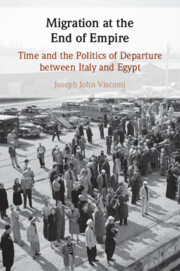Refine search
Actions for selected content:
57 results
9 - Legitimacy and International Membership
- from Part IV - Construction of Legitimacy in International Law
-
- Book:
- The Law and Politics of International Legitimacy
- Published online:
- 14 July 2025
- Print publication:
- 24 July 2025, pp 161-172
-
- Chapter
- Export citation

Exit from International Organizations
- Costly Negotiation for Institutional Change
-
- Published online:
- 29 June 2025
- Print publication:
- 26 June 2025
2 - Exit as a Costly Strategy to Negotiate Change
- from Part I - Introduction and Theory
-
- Book:
- Exit from International Organizations
- Published online:
- 29 June 2025
- Print publication:
- 26 June 2025, pp 34-64
-
- Chapter
- Export citation
7 - Conclusion
-
- Book:
- Inside Parties
- Published online:
- 25 February 2025
- Print publication:
- 24 April 2025, pp 169-182
-
- Chapter
- Export citation
6 - Party Responsiveness
-
- Book:
- Inside Parties
- Published online:
- 25 February 2025
- Print publication:
- 24 April 2025, pp 148-168
-
- Chapter
- Export citation
1 - Introducing Groups and Setting the Stage for Further Discussion
- from Part I - Understanding Groups
-
- Book:
- Groups
- Published online:
- 12 December 2024
- Print publication:
- 05 December 2024, pp 3-23
-
- Chapter
- Export citation
7 - Membership
- from Part III - The Factors Influencing Group Success
-
- Book:
- Groups
- Published online:
- 12 December 2024
- Print publication:
- 05 December 2024, pp 141-161
-
- Chapter
- Export citation
8 - Boundaries of Political Communities and the All-Affected Principle
- from Part II - Membership within and beyond Borders
-
-
- Book:
- Empowering Affected Interests
- Published online:
- 14 November 2024
- Print publication:
- 14 November 2024, pp 142-158
-
- Chapter
-
- You have access
- Open access
- HTML
- Export citation
Introduction
-
- Book:
- Migration at the End of Empire
- Published online:
- 30 May 2024
- Print publication:
- 06 June 2024, pp 1-32
-
- Chapter
- Export citation

Migration at the End of Empire
- Time and the Politics of Departure between Italy and Egypt
-
- Published online:
- 30 May 2024
- Print publication:
- 06 June 2024
7 - Colonial Expansion and the Making of Nations: The Spanish Case
- from Part ii - Paradigm Shifts and Turning Points in the Era of Globalization, 1500 to the Present
-
-
- Book:
- The Cambridge History of Nationhood and Nationalism
- Published online:
- 27 October 2023
- Print publication:
- 09 November 2023, pp 145-162
-
- Chapter
- Export citation
Machine Learning in the study of Star Clusters with Gaia EDR3
-
- Journal:
- Proceedings of the International Astronomical Union / Volume 19 / Issue S368 / August 2023
- Published online by Cambridge University Press:
- 01 August 2025, pp. 86-90
- Print publication:
- August 2023
-
- Article
- Export citation
Is GMM effective in membership determination of Open Clusters?
-
- Journal:
- Proceedings of the International Astronomical Union / Volume 19 / Issue S368 / August 2023
- Published online by Cambridge University Press:
- 01 August 2025, pp. 125-126
- Print publication:
- August 2023
-
- Article
- Export citation
3 - Memory and Identity in Diaspora Cemeteries
-
- Book:
- Dying Abroad
- Published online:
- 30 March 2023
- Print publication:
- 06 April 2023, pp 130-170
-
- Chapter
- Export citation
22 - International Organisations
-
- Book:
- Aust's Modern Treaty Law and Practice
- Published online:
- 13 April 2023
- Print publication:
- 06 April 2023, pp 392-414
-
- Chapter
- Export citation
7 - Policy-Making in SDOs
- from Part III - Governance Architecture and Decision-Making Process of SDOs
-
- Book:
- The Law and Practice of Global ICT Standardization
- Published online:
- 09 February 2023
- Print publication:
- 16 February 2023, pp 163-198
-
- Chapter
- Export citation
3 - Membership
-
- Book:
- Signing Away the Bomb
- Published online:
- 08 December 2022
- Print publication:
- 22 December 2022, pp 49-102
-
- Chapter
- Export citation
Solidarity in Place? Hope and Despair in Postpandemic Membership
-
- Journal:
- Ethics & International Affairs / Volume 36 / Issue 4 / Winter 2022
- Published online by Cambridge University Press:
- 22 December 2022, pp. 487-504
-
- Article
-
- You have access
- Open access
- HTML
- Export citation
The latence of the European colonial past: a reply by the author
-
- Journal:
- European Law Open / Volume 1 / Issue 4 / December 2022
- Published online by Cambridge University Press:
- 21 December 2022, pp. 1063-1066
-
- Article
-
- You have access
- Open access
- HTML
- Export citation
The latence of the European colonial past
-
- Journal:
- European Law Open / Volume 1 / Issue 4 / December 2022
- Published online by Cambridge University Press:
- 21 December 2022, pp. 1059-1062
-
- Article
-
- You have access
- Open access
- HTML
- Export citation
